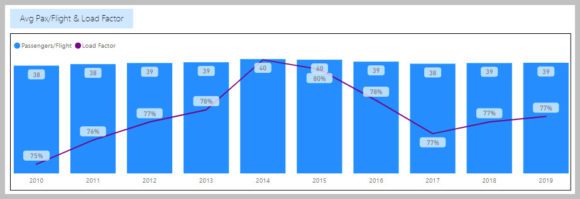
2019 09 06 8 21 47
Yesterday at the RAA conference, De Havilland Canada made their case for their Q400 to be a replacement for the aging 50-seat regional jets. It is a novel idea and timely too. The 50-seat RJ is not renowned for its comfort nor its economics. Is the world ready to go “back” to turboprops?
Let’s start with the market. From our regional data model, we can see that US regionals flying 50-seaters (CRJ2 & E-145) typically have about 40 passengers per flight with a load factor between 70-80%.
Moreover, when we look at the actual work this fleet is performing, we see the following.
Clearly, the regional airlines are moving away from small jets. Passenger numbers are declining but the stages flown has remained stable. What else is happening here? There has been a move to larger regional jets as the next chart illustrates, where we show the CRJ900 and E-175 numbers.
Airlines run according to economies of scale, and this applies especially to regionals. Scale means lower costs and regionals chase lower costs more aggressively than any other type of airline. That is the nature of their business. Notice also the longer stages flown by the larger aircraft. At these ranges, they are starting to approach the typical stages flown by mainline aircraft. This is a hint at why mainline pilots will not give up on scope – they don’t trust their management to protect their jobs. If there were no scope clause regionals would do a lot more (lower cost) flying for the network airlines.
What we can see from the data is that there is a business flying 50-seaters for around 400-mile stages. In 2018 this market represented over 43 million passengers, which is nothing to sneeze at. The key driver in considering moving to the Q400 from a regional jet is going to focus on cost because the market demand is there.
Our models suggest that in 2018 the CRJ200 and E-145 were running at $2,049 per hour. Divide that by 40 seats and we have ~$51 per seat hour.
Here’s where the Q400 starts to become an effective option. It is still being refined and improved. But the 50-seater regional jets are not. The Q400 fuselage offers more flexibility – after all, it can seat up to 90. Which means that at 50 seats, it has a lot of “spare” capacity. The Q400 can serve smaller airports which opens new markets that regional jets probably cannot. The shrink away from smaller communities might, therefore, be reversed with the right tool. On the video above, at the 26-minute mark, Phil Poutissou starts to make the case for the Q400 to compete with the CRJ550.
This includes better seat/mile economics than regional jets. Especially cabin flexibility that allows for bringing bags into the cabin. Poutissou claims the Q400 could be 25% more efficient than the CRJ550 and 13% better than the E-145. Given the small CRJ700 fleet in extant as a feedstock for the CRJ550, the Q400 does appear to offer regional airlines and their network partners an easy to secure solution. The Q400’s speed and climb performance allow it to operate at near-jet speeds. This is a crucial feature to serve as a feeder to network hubs, and network airlines operate at carefully timed “speeds”.
The proposition is worth considering. Today’s turboprop is not what was used in earlier generations of regional airline service.
Views: 8






